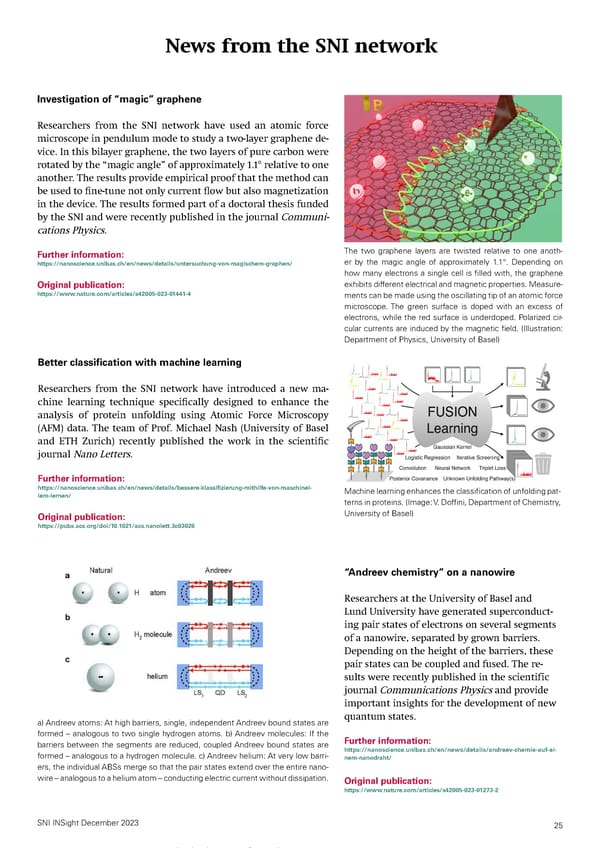News from the SNI network Investigation of “magic” graphene Researchers from the SNI network have used an atomic force microscope in pendulum mode to study a two-layer graphene de- vice. In this bilayer graphene, the two layers of pure carbon were rotated by the “magic angle” of approximately 1.1° relative to one another. The results provide empirical proof that the method can be used to 昀椀ne-tune not only current 昀氀ow but also magnetization in the device. The results formed part of a doctoral thesis funded by the SNI and were recently published in the journal Communi- cations Physics. Further information: The two graphene layers are twisted relative to one anoth- https://nanoscience.unibas.ch/en/news/details/untersuchung-von-magischem-graphen/ er by the magic angle of approximately 1.1°. Depending on how many electrons a single cell is 昀椀lled with, the graphene Original publication: exhibits different electrical and magnetic properties. Measure- https://www.nature.com/articles/s42005-023-01441-4 ments can be made using the oscillating tip of an atomic force microscope. The green surface is doped with an excess of electrons, while the red surface is underdoped. Polarized cir- cular currents are induced by the magnetic 昀椀eld. (Illustration: Department of Physics, University of Basel) Better classification with machine learning Researchers from the SNI network have introduced a new ma- chine learning technique speci昀椀cally designed to enhance the analysis of protein unfolding using Atomic Force Microscopy (AFM) data. The team of Prof. Michael Nash (University of Basel and ETH Zurich) recently published the work in the scienti昀椀c journal Nano Letters. Further information: https://nanoscience.unibas.ch/en/news/details/bessere-klassifizierung-mithilfe-von-maschinel- Machine learning enhances the classi昀椀cation of unfolding pat- lem-lernen/ terns in proteins. (Image: V. Dof昀椀ni, Department of Chemistry, Original publication: University of Basel) https://pubs.acs.org/doi/10.1021/acs.nanolett.3c03026 “Andreev chemistry” on a nanowire Researchers at the University of Basel and Lund University have generated superconduct- ing pair states of electrons on several segments of a nanowire, separated by grown barriers. Depending on the height of the barriers, these pair states can be coupled and fused. The re- sults were recently published in the scientific journal Communications Physics and provide important insights for the development of new a) Andreev atoms: At high barriers, single, independent Andreev bound states are quantum states. formed – analogous to two single hydrogen atoms. b) Andreev molecules: If the Further information: barriers between the segments are reduced, coupled Andreev bound states are https://nanoscience.unibas.ch/en/news/details/andreev-chemie-auf-ei- formed – analogous to a hydrogen molecule. c) Andreev helium: At very low barri- nem-nanodraht/ ers, the individual ABSs merge so that the pair states extend over the entire nano- wire – analogous to a helium atom – conducting electric current without dissipation. Original publication: https://www.nature.com/articles/s42005-023-01273-2 SNI INSight December 2023 25 SNSF Starting Grant für Jonathan de Roo Der Schweizerische Nationalfonds (SNF) vergibt sechs weitere SNSF Starting Grants an die Universität Basel. Prof. Dr. Jonathan De Roo, Assistenzprofessor mit Tenure Track am Departement Chemie der Universität Basel, bekom- mt einen dieser Grants, um recycelbare Schwämme mit programmierbaren Strukturen aus Metall-Oxo-Clustern zu entwickeln. Diese Schwämme 昀椀nden Anwendungen als Katalysatoren, beispielsweise in der Herstellung von Arzneimitteln oder bei der Wasserreinigung. Weitere Informationen: https://nanoscience.unibas.ch/de/news/details/snsf-starting-grant-fuer-jonathan-de- roo/
 SNI INSight December 2023 Page 24 Page 26
SNI INSight December 2023 Page 24 Page 26